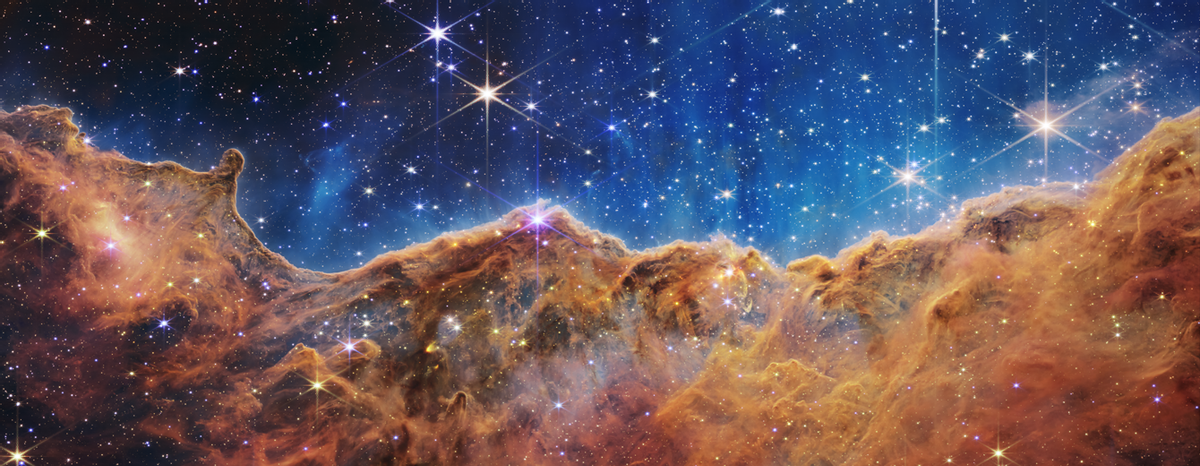More than six months after initially launching to space in December 2021, the James Webb telescope shed new light on humankind's scientific understanding of the universe. On July 12, 2022, NASA revealed stunningly in-depth images captured by the telescope, giving us a new look at areas of our universe as they appeared billions of years ago.
The White House and NASA gave a sneak peek of the telescopic discovery the day prior, when U.S. President Joe Biden released a first-of-its-kind infrared image at a press briefing. The image was taken by Webb’s Near-Infrared Camera (NIRCam) and showed the galaxy cluster dubbed "SMACS 0723." The image was the result of many composite images taken at different wavelengths over 12.5 hours.
"The image covers a patch of sky approximately the size of a grain of sand held at arm’s length. It’s just a tiny sliver of the vast universe,” said NASA Administrator Bill Nelson during an unveiling event at the Goddard Space Flight Center.
The image showed SMACS 0723 as it appeared 4.6 billion years ago.
“Light from these galaxies took billions of years to reach us. We are looking back in time to within a billion years after the big bang when viewing the youngest galaxies in this field. The light was stretched by the expansion of the universe to infrared wavelengths that Webb was designed to observe,” wrote NASA.
As Mashable reported, a previous image of the SMACS 0723 galaxy was captured by the Hubble Telescope in 1995. That 1995 image took weeks to capture, not 12.5 hours. On July 11, UX designer Jason Short created and shared a GIF showing the differences between the two images:
Other social media users made similar comparisons between the two images, including the Space And Planetary Science Twitter account:
After Biden's initial reveal, NASA released its full Webb series, including an image dubbed the “Cosmic Cliffs” that NASA said showed a “landscape of ‘mountains’ and ‘valleys’” on the edge of a stellar nursery called "NGC 3324." Located at the northwest corner of the Carina Nebula, NGC 3324 has stars in a region that was previously invisible. But, with Webb’s sensitivity to infrared light, that area has now been illuminated.
“Called the Cosmic Cliffs, Webb’s seemingly three-dimensional picture looks like craggy mountains on a moonlit evening. In reality, it is the edge of the giant, gaseous cavity within NGC 3324, and the tallest ‘peaks’ in this image are about 7 light-years high,” wrote NASA.
“The cavernous area has been carved from the nebula by the intense ultraviolet radiation and stellar winds from extremely massive, hot, young stars located in the center of the bubble, above the area shown in this image.”
Also, as part of the July 2022 series, NASA released a new image of Stephen’s Quintet, a series of five galaxies that scientists hope will help inform our understanding of how galaxies interact with one another, and how they trigger star formation.
Pictures of two orbiting stars within the Southern Ring Nebula were part of the series, too. In the below-displayed tweet, the right image showed a star that is surrounded by dust. Meanwhile, the brighter star (left) is in an earlier stage of stellar evolution and “will probably eject its own planetary nebula in the future,” said NASA.
“As the pair continues to orbit one another, they ‘stir the pot’ of gas and dust, causing asymmetrical patterns,” wrote NASA. “Each shell represents an episode where the fainter star lost some of its mass. The widest shell of gas toward the outer areas of the image were ejected earlier.”
Launched Dec. 25, 2021, the James Webb Telescope (also called JWST or simply Webb) is an infrared telescope that scientists considered to be the “premier observatory” for the upcoming decade. It aimed to study each phase of our universe's history as part of an international collaboration between NASA, the European Space Agency, and the Canadian Space Agency.
